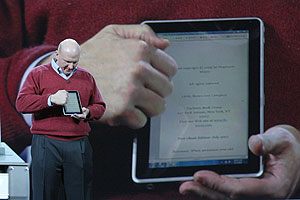LAS VEGAS – Jan. 6, 2010 – The Consumer Electronics Association kicked off the 2010 International Consumer Electronics Show (CES) tonight with a pre-show opening keynote by Microsoft CEO Steve Ballmer and Entertainment & Devices President Robbie Bach.

Microsoft CEO Steve Ballmer demonstrates new hardware during his keynote address at 2010 CES.
Over 110,000 manufacturers, content providers, corporate buyers, engineers and media people converge each year in Las Vegas to identify the latest trends in consumer technology. More than 2,500 exhibitors show off their gadgets and technologies — from e-readers and 3-D televisions to free-standing solar panel systems.
During his keynote Ballmer highlighted the unprecedented innovation in the consumer electronics industry during 2009. Despite the economic turmoil the industry continued to deliver exciting new products and services at pace and, in Ballmer’s view, is set up for continued success.
Consumers Choosing Microsoft
2009 was a big year for Microsoft according to Ballmer, and he was optimistic about the opportunities to continue the success in 2010. From Windows 7 and Bing to Xbox LIVE, Microsoft has rolled out products that have won praise from reviewers and strong acceptance from consumers, and the company has a pipeline of exciting new products planned for 2010.
Ballmer highlighted recent success, starting with the latest sales numbers on Windows 7, and showcased some of the innovative new hardware manufacturers continue to roll out.
Windows 7
-
Windows 7 is by far the fastest selling operating system in history. PC sales jumped nearly 50 percent the week Windows 7 launched.
-
On Black Friday, retailers sold 63 percent more PCs than they did the year before.
-
According to NPD, the 2009 holiday season saw greater than 50 percent year-over-year growth for Windows PC sales.
Current and future hardware shown on stage included:
-
A new touch-enabled slate PC from HP
-
The Sony VAIO L all-in-one laptop built for HD entertainment and multimedia content creation, and including a 24-inch touchscreen
-
The Lenovo A300, one of the thinnest PCs yet at just 18mm, but with a 21.5-inch HD widescreen LED display
Bing
Bing saw big progress in 2009. Ballmer confirmed that in the few months following its introduction in June, Bing had added 11 million new users and grown market share.
In addition, Ballmer announced that Microsoft and HP are teaming up on search and portal experiences. Bing will be the default search engine, and MSN the default homepage on HP PCs in 42 countries.
Xbox and Xbox LIVE
Ballmer looked back at 2009 and confirmed that Xbox and Xbox LIVE set new records:
-
There are now over 39 million Xbox 360 consoles around the world, and more than 500 million games have been sold.
-
Between Christmas and New Years Day, Xbox LIVE experienced its busiest week ever, adding a new member every second and a record of more than 2.2 million concurrent members online.
-
Nearly 10 million people have logged into Xbox LIVE’s nongaming applications — Facebook, Twitter, Netflix, Last.fm, Sky, Canal and Zune — using their Xbox as a way to stay connected to friends and family.
-
Xbox LIVE membership is now an active community of over 20 million people.
Windows Phones
Following the release of Windows Mobile 6.5 in October, Ballmer announced the upcoming exclusive availability of the HTC HD2 in partnership with T-Mobile USA, Inc. and HTC. Like other Windows phones on the market, the HD2 offers great customer experiences through an easy-to-use interface, extensive browsing capabilities and access to valuable services.
Delivering on the Connected Entertainment Vision
Microsoft Entertainment & Devices Division President Robbie Bach followed Ballmer on stage and outlined the company’s strategy of connecting the personal computer, mobile devices, television and the Internet.
In an interview before CES, Bach discussed the potential of technology to change the entertainment experience. “We’ve reached a point with technology where it’s very feasible to listen to or watch whatever you want, whenever you want, whether on your smartphone, laptop or a connected TV in the comfort of your living room,” he said. “That concept of greater control is compelling to many people. It’s all about tying together these disparate technologies into a digital entertainment experience that’s consistent, easy to use and relevant to consumers’ needs.”
Mediaroom 2.0
As part of Microsoft’s digital entertainment strategy, Microsoft announced Microsoft Mediaroom 2.0, the next version of its Internet Protocol Television solution for service providers. Mediaroom 2.0 gives service providers the ability to offer their subscribers features such as these:
-
The ability to stream live and on-demand content to the TV but also devices such as PCs and phones
-
The same on-demand experience on the PC with Windows Media Center in Windows 7
Xbox Gaming and “Project Natal”
Xbox plays a multifaceted role in Microsoft’s digital entertainment strategy from gaming to changing the face of social entertainment, and Bach highlighted exciting plans for 2010:
-
An lineup of what promises to be blockbuster exclusive games including Tom Clancy’s Splinter Cell: Conviction, Crackdown 2, Mass Effect 2, Alan Wake, and Fable 3
-
The release of what will likely be the biggest game of the year, Halo Reach, continuing the Halo saga
-
The new Game Room on Xbox LIVE, which will be the place to relive the glory days of arcade games, with over 1000 games being released throughout the next three years
Then Bach gave a behind-the-scenes look at the work behind “Project Natal,” the controller-free gaming experience that tracks movement of the body and facial expressions, and even responds to your voice.
Scheduled to be available in holiday season 2010, “Project Natal” is only the most recent example of Microsoft’s work creating natural user interfaces. Other examples include Microsoft Surface, Windows Touch and Ford SYNC, the voice-controlled, in-car communications and entertainment system that Microsoft jointly developed with Ford.





